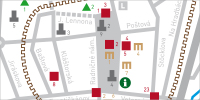                   
      |
Beyond the town’s outer walls lies one of the most precious Jewish cultural monuments in Central Europe – the Jewish Suburbia. The unique nineteenth century urban complex consists of a synagogue, ritual baths (Mikvah), an assembly hall (Beit Midrash) and adjacent facilities including a kosher abattoir. In the past, the Jews were forbidden to inhabit royal towns such as Bardejov and thus the suburbia is located outside of the town’s walls.
After Battle of Mohács in 1526 the Jews of the Upper Kingdom of Hungary were banished from towns and forced to live outside of its limits. Such a community was formed northwest of Bardejov’s core. The oldest source mentioning Jewish presence around the town is dated to 1599. A source from 1631 mentions two Jewish individuals that were banished from the town. A register from 1738 mentions only one family of a distiller, originally coming from Polish town of Zamość. In 1767 there were 17 Jewish persons who made their living by selling spirits and paid double taxes.
The Jews were forbidden to own land and thus had to focus on business and crafts instead. The makeup of the local population changed by the arrival Guttman family in the early eighteenth century. The arrival of Hasidic Jews from Galicia signaled the flourishing of local Jewish community. In 1784, there were altogether 14 Jewish families (all in all 67 people) mostly around the outskirts of the town. They belonged to the religious community of Zborov and had their own prayer hall. At the end of the eighteenth century Jewish merchants received their first permission to trade in the town center.
|
Jewish presence left its mark on local architecture, in particular by the construction of the great synagogue from 1771 to 1773. However the building burned down in subsequent years and was replaced a by a new synagogue in 1810. The later remains standing till today. The so called Old Synagogue, as a Hebrew inscription from the women’s gallery confirms, is the oldest part of the suburbia. The text makes a reference to the end of construction works on the 1st of Elul 5596, which corresponds to the 14th of August 1836.
There are only 2 examples of such 9-arch synagogues in Slovakia (the other being in Stupava). The synagogue is positioned in the center, among other structures, as the Jews were forbidden to build lavish temples in public areas. The interior consist of an antechamber, small study room, main male prayer-hall and a female gallery. The principal area is composed of nine arches and supported with four pillars. One of these is the Bimah – an elevated podium used for reading Torah.
The arches of the synagogue are covered by rich nineteenth century painting sporting floral ornaments. A Hebrew inscription, located above the entrance do the main hall of the western wall, ranks among the most valuable artefacts. The poetic text mentions the synagogue’s donors and the time of its construction. At present, the building does not serve its original purpose.
The oldest reference to the suburbia itself comes from an 1877 town map. Bardejov’s Jewish community agreed to modernization of the complex at the end of the nineteenth century. Part of this process involved the addition of Mikvah, Beit Midrash, a tower with boiler and a kosher abattoir.
|
The ritual spa Mikvah served both Jewish and non-Jewish inhabitants of the town. The front facade of the spa features a holocaust memorial plaque.
Beit Midrash, an assembly hall, served as a school as well as a smaller place of prayer.
The suburbia was created on the basis of the Talmud doctrine and was in service until 1944. The complex is undergoing reconstruction for further social-cultural purposes.
There were originally three synagogues in the early twentieth century Bardejov. Two remain – the Old Synagogue in the Jewish Suburbia and the Synagogue of Bikur Cholim on Kláštorská Street. A Jewish cemetery located in the northern part of the town holds around thousand tombstones of renaissance, baroque and classicistic style.
The Jewish Suburbia was registered into UNESCO World Heritage in 2000, together with the historical core of Bardejov. The multitude of ethnicities contributed to the sophisticated period urban culture and as such the suburbia is an inseparable part of the UNESCO registration.
A unique holocaust memorial was introduced in 2014 near the area of the complex. It contains names of more than 3000 victims, arrayed according to their respective families. The memorial garden serves as a symbol for the final rest of Bardejov’s Jews as well as for conciliation of town’s inhabitants with their own past.
Translated by:
Mgr. Samuel Beňa, M.A.
More about Jewish Suburbia:
www.suburbiumbardejov.sk
|

































